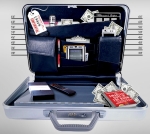Home » Product Placement
» Page: 1 | 2 | 3 | 4 | 5 | 6 | 7 | 8
Blaming the high cost of branded entertainment production and, according to one anonymous BMW exec who blamed German bureaucracy, BMW has ended its use of branded entertainment. BMW, of course, spawned branded entertainment in its current form with its The Hire films. The fact the car maker recently switched entertainment agencies, had its entertainment exec leave and is in the middle of an agency review, surely, contributed to the move.
In an effort to institutionalize branded content, Stephen Mitchell, creator of the 80's television show Interview, has proposed a writing curriculum, called Branded Alliance, to educate people on the creation of brand integrated concepts suitable for feature films, television, alternative media and games. Mitchell hopes the course creates a pool of talent capable of generating entertainment/advertising content for marketers.
Mitchell says the course will stress a conceptual and innovative approach to the subject of brand integration. Students will be instructed in the art of blending story content and corporate message in a manner that is seamless. "Unlike product placement, which can be done by the numbers, there is no single definition of branded entertainment," Mitchell says. "It also forces us to redefine 'product,' for it can be a label, an idea, a city or anything else that that has the backing of corporate partner. At least this sounds a bit more honest than the television show which duped viewers (Hollywood elite) into believing the interviews were real versus stunts to promote Mitchell's work.
more »
Sure to make each episode as laborious as Trump's The Apprentice, Buick, Delta, Song, Random House, Westin Hotels and others have signed with Mark Burnett to be part of the new Apprentice: Martha Stewart. While the blatant intrusiveness of these full episode sponsorship may grate on the nerves, they bring in millions. The aggravation may be offset by Martha herself who, we venture to say, will be far more interesting than Trump.
Today, we can't seem to get away from the topic of product placement. We received a link from Terry Heaton of Donata Communications who, last night, saw an episode of the USA alien abduction show, The 4400, in which Budweiser had a blatant placement Heaton thought went over the edge of credibility.
On his blog, he describes the scene, writing, "Following the funeral of one of their Korean War buddies, a group of guys head to a local pub to lift a few and remember the fellow. A story is told where one of the guys 'returned with three cases of Budweiser,' whereupon one of the guys lifts a can. The camera takes a tight shot. The guy says, 'Look at this can. It's just like it was back then.' Cut to a wide shot that shows the table is full of Budweiser cans."
While Heaton is one man, others certainly reacted as he did. "The writers of this show must have had a fit over writing this. Here's an entire scene in a drama that was created to sell Budweiser beer. Frankly, it ruined the show for me. An essential part of good drama is to draw the viewer into the story. That'll never happen again for me with this program."
If product placement generates this sort of reaction, it's not the sort of marketing tactic that'll stick around for long.
On her arrangement with several magazines to use images of Lexus vehicles in editorial, Lexus VP of Marketing Deborah Wahl Meyer told Ad Age, "I'm not talking about pushing anyone to do this We highly respect what a journalist and editor do. We're not talking about crossing any boundaries that are well established." Clearly, the simple act of asking certainly crosses the line. It places journalist in a compromising position. They have been influenced whether they decided to go along with the request or not. Don't worry. We haven't turned into a myopic infant. We know this stuff been going on forever but slowly and surely the line between editorial and advertising is becoming obliterated. Uninfluenced, independent commentary is becoming increasingly difficult to find.
As evil as this may sound, people still have brains, whether marketers realize this or not, and they will adjust to this blurring of reality. Though, it's just not something that needs to be there in the first place. Lending a bit of humor to this magazine product placement trend is the hilariously clandestine, hush-hush attitude both sides have taken on as if knowing which publishers and which marketers are in bed together is as important as codes to detonate a nuclear device.
Adrants reader brings to our less than sports-minded attention a stunt Chevy pulled during Tuesday's Major League Baseball All-Star game during which FOX cameras panned, in feigned innocence, over a fan banner that read HHRYA.com. While broadcasters Joe Buck and Tim McCarver bantered back and forth about the banner, apparently, no one realized it was a paid placement for the new Chevy HHR vehicle directing people to a website that, according to The Register, was swamped and offline for for thirty minutes. The site is a repository for people to upload pictures of themselves with the letters HHR somewhere in the photo.
more »
Citing video news releases, product placement and interactive television aimed at children, FCC Commissioner Jonathan Adelstein has asked the FCC to expand its investigation into product placement disclosure and strengthen guidelines. As reported in As Age, Adelstein told the Media Institute, "People out there are frustrated by what they see as fake news and relentless marketing. The use of covert commercial pitches is penetrating deeper and deeper into our media."
While our normal pithiness calls for us to poke fun at government agencies creating rules that assume people are stupid and can't figure things out for themselves, we, believe it or not, feel some control is warranted. Advertising, because of people's increased ability to ignore it, is getting desperate. very desperate. A roadblock buy once meant buying every spot on every network during a single time period or plastering posters over an entire subway station. It now means, literally, creating an advertising barrier so intense, so pervasive one would have to leave the solar system to avoid an ad. It's reached the point on insanity as marketers, who are not entirely at fault since they are faced with intense media fragmentation and consumer control over media, grasp for any and all possible means to get their message in front of potential customers.
While inviting the government into things is not always the best solution, something, anything is needed to guide the advertising beast as it relentlessly seeks eyeballs with cash.
Adrants reader Ed Misley wrote he just saw the documentary movie, "Enron: The Smartest guys in the room," and noted a prominent Coke product placement he thought quite odd. He writes, "During many scenes of Jeffrey Skilling testifying before congress they digitally edited a Diet Coke can (with the logo prominently facing the camera). Now because of how they cropped the scene, the coke can was almost the size of his head. Now I watch a lot of C-Span and I don't remember a time when I saw anything other than glasses and pitchers of water on the tables of those testifying. Why would Coca Cola Crop pay good money to have their product next to the bad guy?"
He continued, commenting upon a second product placement, "I also noticed a more subtle product placement of a water bottle, which I think was "Spring Hill" due to the green label but it was turned in such a way as to not see the label entirely. Was this a ruse to divert attention away from the suspicious coke can? This was during an exchange of words between Barbara Boxers and Jeffrey Skilling. Skilling had the blatant coke and Boxer had the subtle water bottle. The coke can appeared almost every time you saw Skilling testifying. I am not anti-adverting I just can't figure out why this would help either Coca Cola or the filmmakers."
Well, unfortunately, Ed, it's all about the money. While we haven't seen the movie and can't comment directly, we suspect somebody needed money, Coke had money, transaction happened.
Even stuffy, upper crust Broadway isn't immune to product placement as recently illustrated in a deal between Neil Simon's Sweet Charity, starring Christina Applegate, and tequila maker Jose Cuervo for its Gran Centenario brand. Simon approved a script change to incorporate the brand into the dialog. The brand logo will also appear in set and ads will be placed in the playbill. New York-based Bridge to Hollywood/Broadway put the deal together. Bridge to Hollywood/Broadway has previously brokered product placement deals for appearances in Thoroughly Modern Millie and Raisin in the Sun. What are readers thoughts on product placement in Broadway shows and product placement in general? Over the top marketing insanity or standard modus operandi?
AdJab points to a leaked internal Ford memo outlining the car manufacturers upcoming product placement plans. Infiltrating such shows as Extreme Makeover with e Ford Mustang-themed room to Dr. Phil with a Ford Five Hundred giveaway to a loyal viewer to a TRL placement in which Funkmaster Flex will highlight prom vehicles such as the Excursion Limo (gotta have lots of make out room) and the Mustang GT Convertible. other placements include American Idol, Sabado Gigante and the Gospel Music channel. So much for surprises. Entire memo hosted at StayFree.
Home » Product Placement
» Page: 1 | 2 | 3 | 4 | 5 | 6 | 7 | 8

|
|






